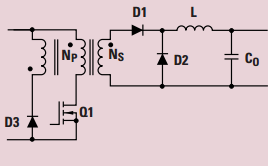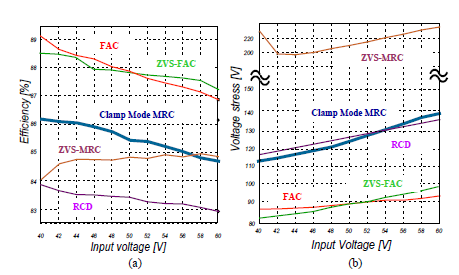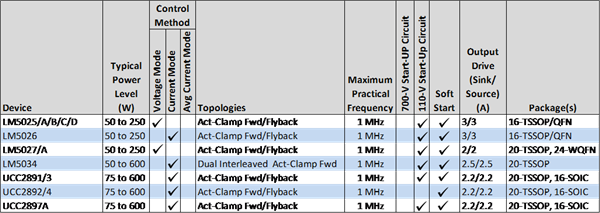SSZTC11 october 2015 LM5025A , UCC2897A
There is so much attention given to flyback and LLC power-conversion topologies, I thought it was time to visit an old friend: the forward topology. It has been widely used for decades and for good reason. It is hard to find a single-ended topology that delivers uniformly high marks in design simplicity, low cost and good efficiency. It is especially well suited for lower- to mid-range power applications (less than 300W) that require high output currents.
 Figure 1 Basic Forward Topology Taken
from TI Power Supply Topologies Poster
Figure 1 Basic Forward Topology Taken
from TI Power Supply Topologies PosterThe key advantages that the forward converter has over a flyback include better transformer utilization, lower peak currents and a filtered output.
Alas, the single-switch forward converter is not without inherent problems such as transformer core saturation, voltage spikes caused by the transformer leakage inductance, and switching loss. Using a resistor-capacitor-diode (RCD) clamp addresses the reset of the transformer, and the active clamp forward (ACF) uses an auxiliary switch to replace the RCD clamp’s diode and resistor to reduce leakage. zero voltage-switching (ZVS) techniques are used to address switching loss.
In Ching-Shan Leu’s paper, “Improved Forward Topologies for DC-DC Applications with Built-In Input Filter,” the author compares the various approaches against results of the two main characteristics that all of these methods are trying to improve: efficiency and voltage stress. Figure 2 supports Leu’s conclusion that ACF (referred to as FAC in Figure 2) has the best performance, offering the lowest stress combined with the highest efficiency.
 Figure 2 Comparison of Efficiency and
Voltage Stress in Forward Converters
Figure 2 Comparison of Efficiency and
Voltage Stress in Forward ConvertersTexas Instruments has a broad selection of ACF topologies shown in Table 1, with the LM5025A voltage mode and the UCC2897A current mode among the most popular.
 |
TI also offers over 79 and counting active-clamp TI Designs reference designs for free download. For example, the very popular Telecom Bus Converter for Module Replacement reference design (with seminar materials) is a 175W telecom ACF design (5V@35A) in a very small form factor with up to 95% efficiency and lower conduction losses than a flyback.
The active clamp forward converter has several key advantages, and offers the best efficiency and lowest voltage stress from the forward topologies presented. It’s okay to be a bit forward: begin your active clamp design today.
Additional Resources
- Explore more TI Designs reference designs for forward active clamps
- Learn more about the UCC2897A and LM5025A